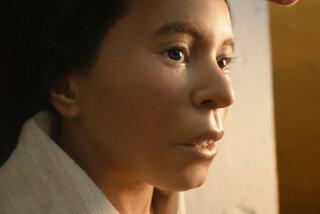On Lake Titicaca, Listening for the Incas, Hearing the Whispers of Childhood
- Share via
COPACABANA, Bolivia — I first heard the name Lake Titicaca in my sixth-grade geography class. Once the snickering stopped, most of us thought it would be a cool place to visit. After 32 years, I went to see for myself.
It wasn’t hard to find. Andrea and I hopped a northbound bus in La Paz, and three hours later we stood on the shore of the lake that legend claims gave birth to the Incas and the sun. Straddling the border of Bolivia and Peru at 12,500 feet, it’s one of the highest navigable lakes in the world. Some say it evokes the Mediterranean, but with the snow-covered Andes in back, that’s a stretch.
I expected to see indigenous people crossing the lake in dugout canoes. Instead I found Indians renting paddle boats on the beach, steps from a kiddie merry-go-round. What would the Incas say?
Our hotel, La Cupula, was more attractive, if less authentic. Run by a German and Egyptian couple, the white-domed inn stands on a hillside of eucalyptus overlooking this dusty town and the blue lake. We liked the abstract painting in our room so much, we bought it. In the round restaurant with wrought-iron seat backs resembling Picasso figures, we ate pink filets from trout the size of barracuda.
On the Plaza 2 de Febrero, cars, trucks and buses lined up in front of the Moorish-style cathedral, waiting to be blessed by a priest wearing a baseball cap. Women in bowler hats and ruffled skirts sold garlands, ribbons, wreaths and other vehicular ornaments. The priest sprinkled holy water on the engines and on the heads of drivers and passengers, praying for a safe journey. Following tradition, travelers toasted themselves before dousing tires and bumpers with beer and champagne. The ritual seemed counterproductive when one bus driver downed six glasses of beer and climbed behind the wheel.
In the morning, we boarded a double-decker boat for Isla del Sol (Island of the Sun), where it’s said the first Inca emperor, Manco Capac, and his sister-wife, Mama Ocllo, mystically appeared. The lake was an angry sea, with whitecaps and rolling swells. Our boat was named Titicaca, a comfort when I saw that several other boats lurching on the water were christened Titanic.
In the village of Cha’llapampa, a local stopped his soccer game to open the Isla Museo for us. The tiny museum contains medallions, vases, puma-faced incense burners and other artifacts of the pre-Inca Tiahuanaco culture recovered 25 feet underwater. A trail climbed past mud houses up the mountain to a rock slab thought to have been used by Incas for human and animal sacrifices. Nearby, the labyrinthine Chincana Ruins crumbled above a crystal bay.
We hiked seven miles along the island’s spine, terraced fields tumbling to the lake on either side. Women tilled the dull ground, children at their hips. We passed cattle, sheep, pigs, a dog with the head of a German shepherd and the body of a basset hound.
The trail ended at the Escalera del Inca (Inca Stairway) and Fuente del Inca (Inca Springs), where natural spring water spills down channels along ancient stone steps. Spanish explorers thought they had discovered the fountain of youth. Today, at the bottom of the stairs, Indians sell Cokes and Pringles, and girls pose with llamas for money.
I wanted to take the first boat back to the mainland, but the captain made us wait for the second. I was miffed until I saw I now had time to skip rocks across the water, something I would have done had my sixth-grade class come here on a field trip. Trouble was, the Incas long ago skipped all the best rocks on Lake Titicaca. Still, after 32 years, it was good to finally put a place with the name.
NEXT WEEK: Running scared in South America.
Did you miss a Wander Year installment? The entire series since it began in January can be found on The Times’ Web site at https://www.latimes.com/travel/wander.
More to Read
Sign up for The Wild
We’ll help you find the best places to hike, bike and run, as well as the perfect silent spots for meditation and yoga.
You may occasionally receive promotional content from the Los Angeles Times.






